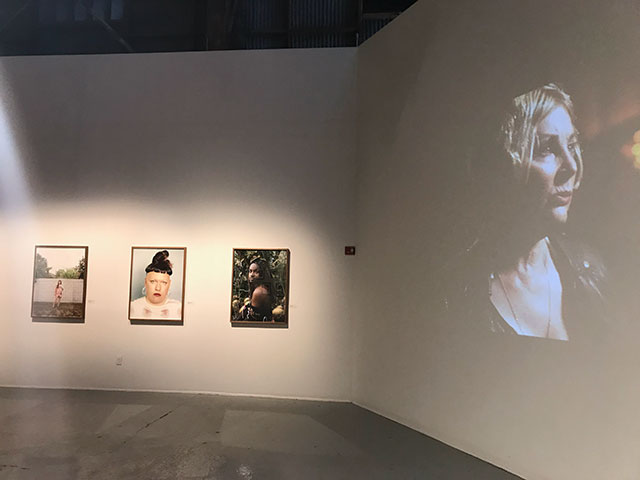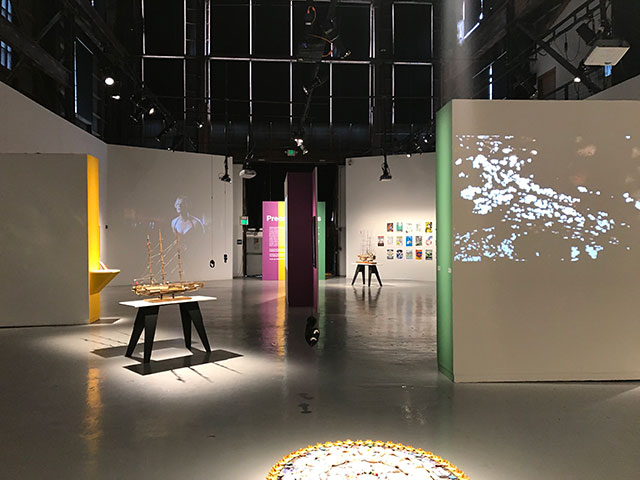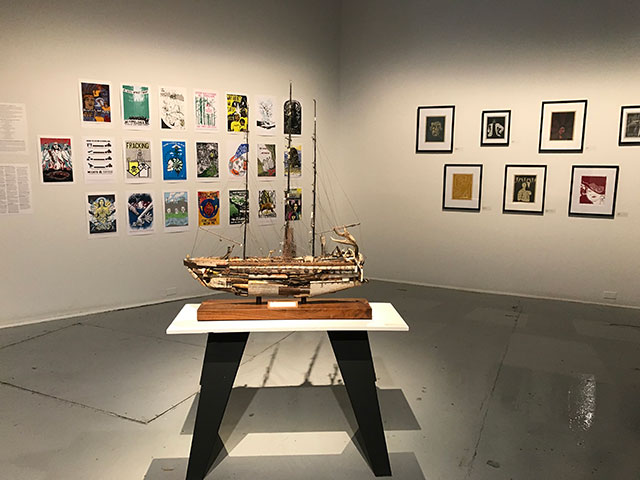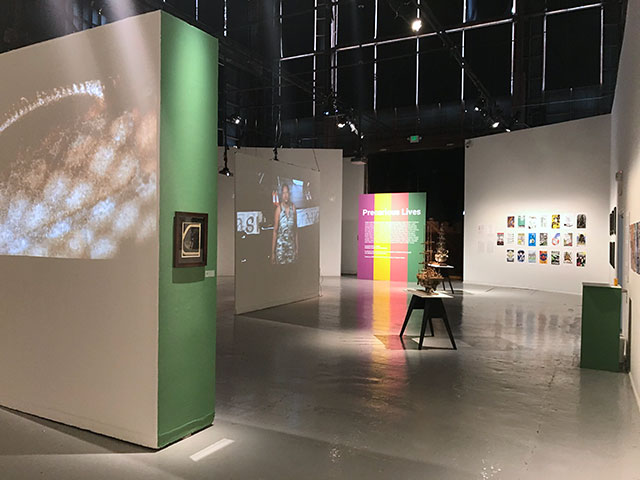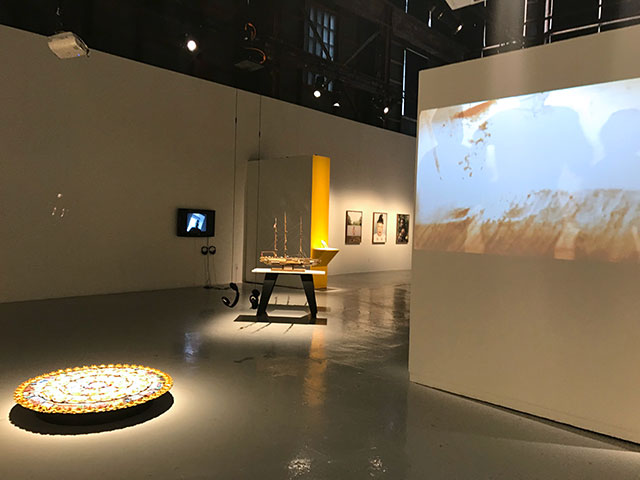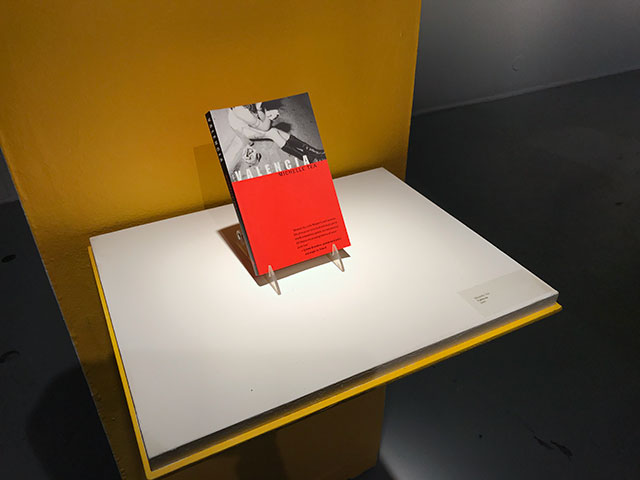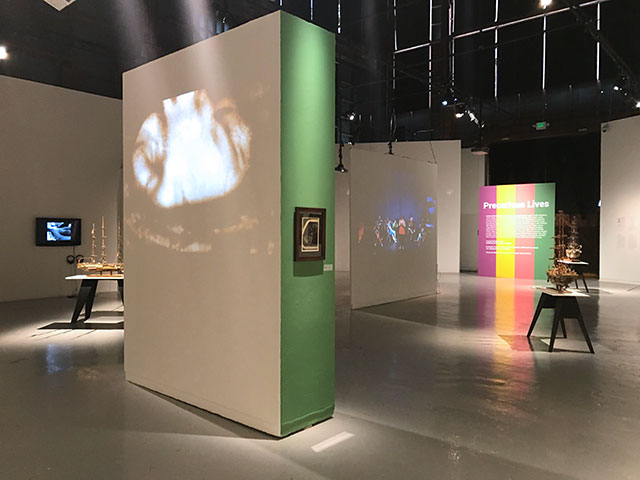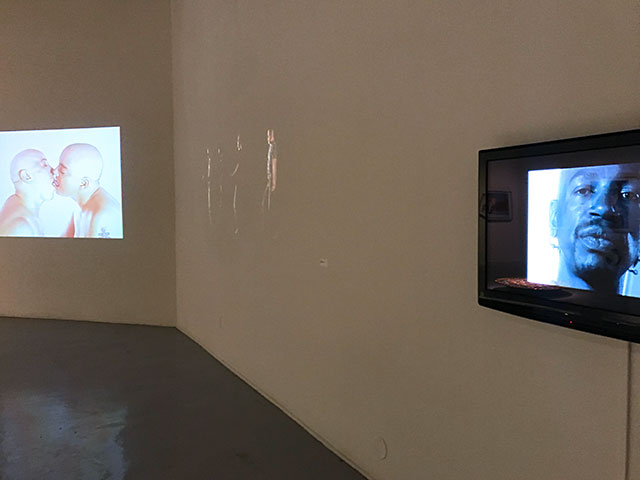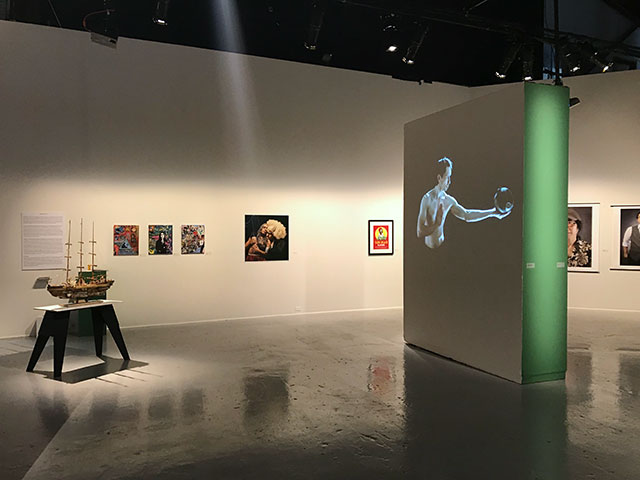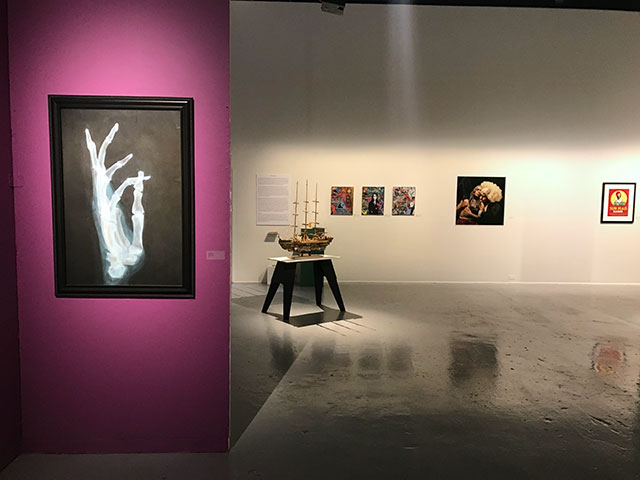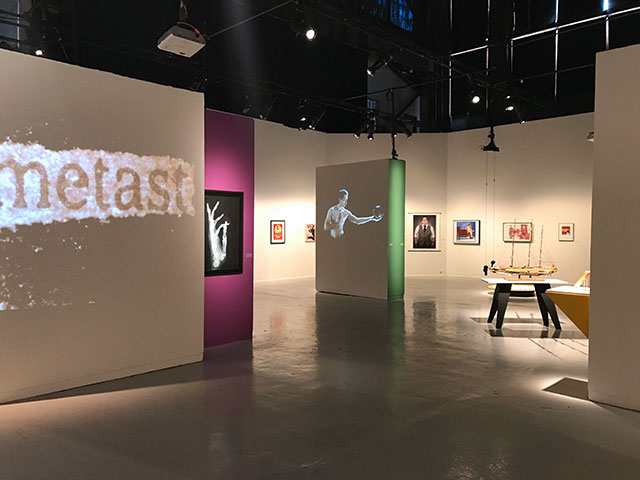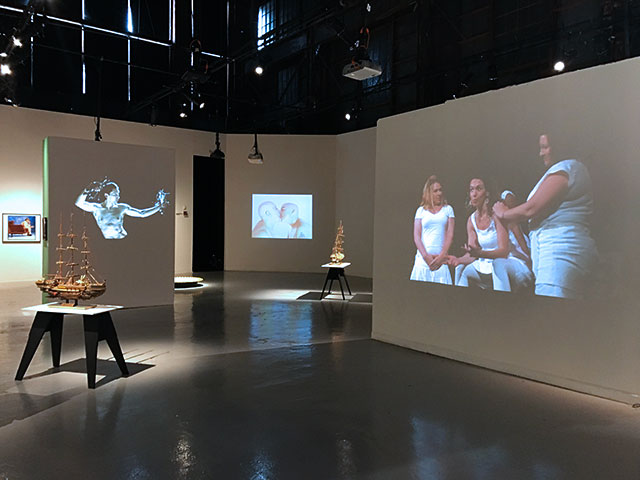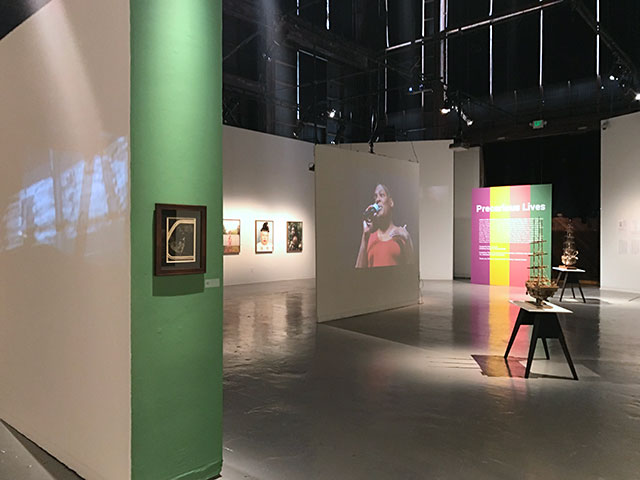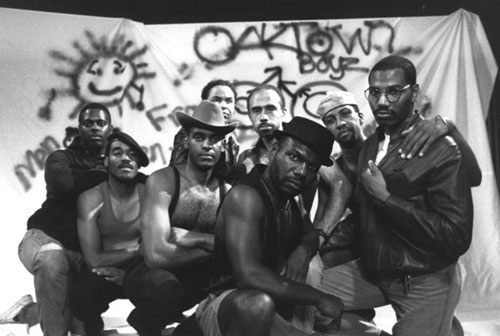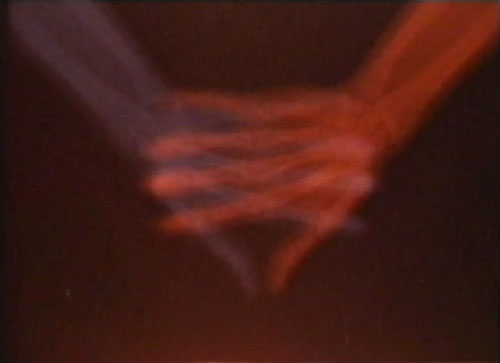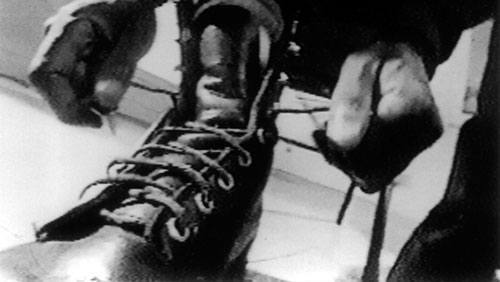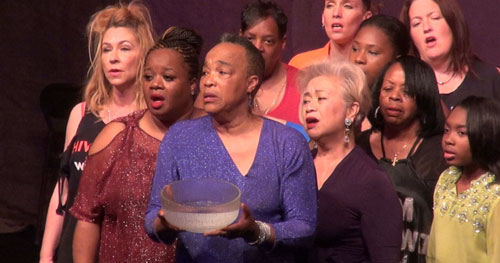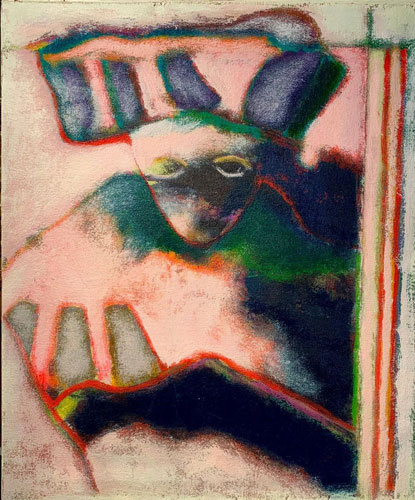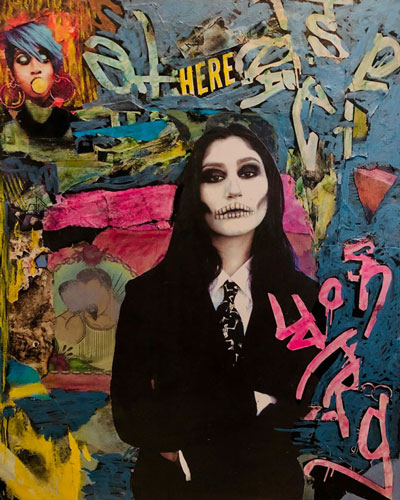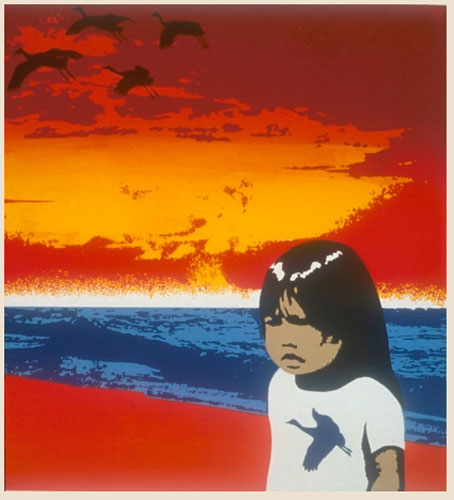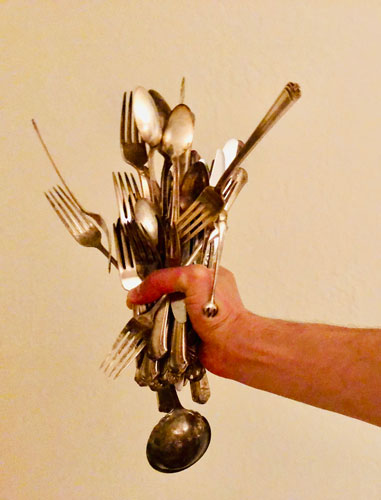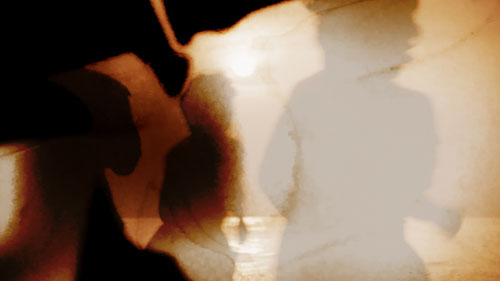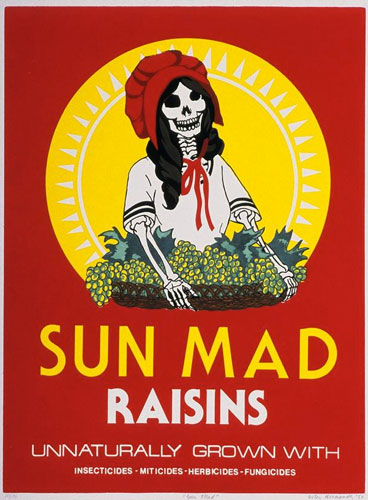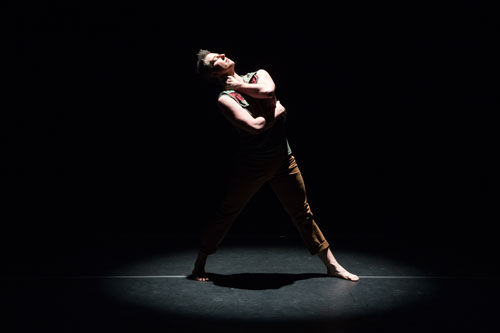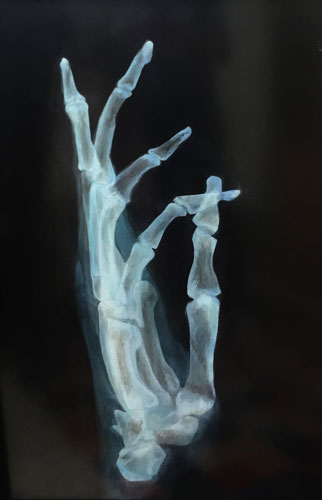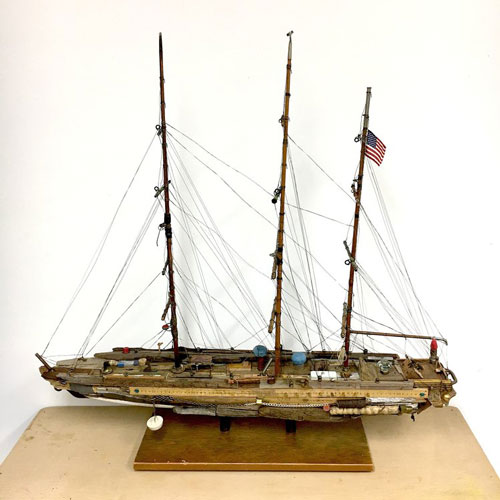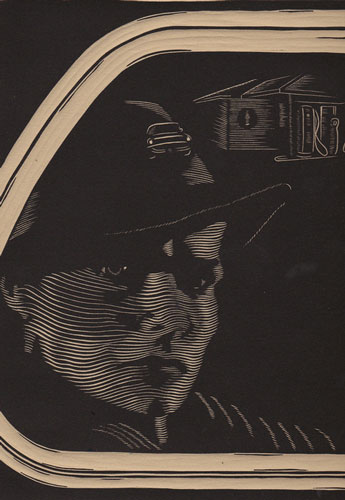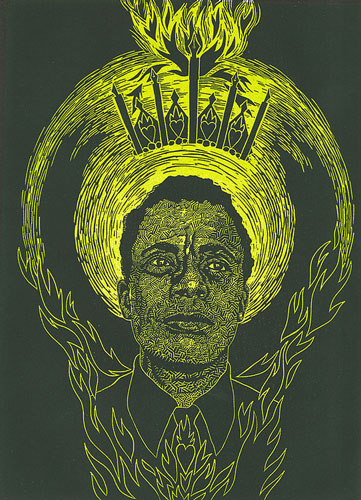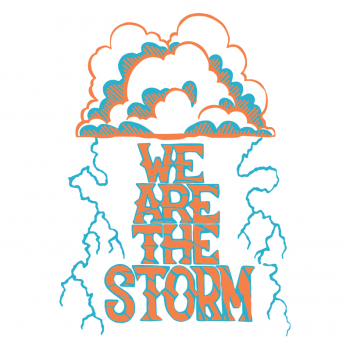Precarious Lives
Creative Labor presents:
Precarious Lives – Visual Art Exhibition
Curated by Rudy Lemcke
Thursday, June 6–Saturday thru June 29, 2019
Precarious Lives (visual art exhibition) marks the 22nd annual National Queer Arts Festival visual arts exhibition hosted by SOMArts Cultural Center. This year’s Creative Labor exhibition opens its field of view beyond its primary focus on creating a site of visibility for queer art to include the work of non-queer identified artists whose work has been instrumental in building the social and aesthetic network within which we understand and experience cultural difference and our own queerness. The exhibition looks outward from the public space SOMArts has created over the years – a safe, welcoming, inclusive physical place that affirms our presence as valued art-workers in our increasingly unsettled times.
The artists in the exhibition include: Marlon Riggs, Barbara Hammer, Lordes Portillo, Rhodessa Jones, Carlos Loarca, René Yanez, Guillermo Gómez-Peña, RJ Muna, Nancy Hom, Justin Hoover, Michelle Tea, Bernice Bing, Madeine Lim, Tina Takemoto, Annie Sprinkle and Beth Stephens, Flo Wong, Lenore Chinn, Ester Hernandez, Ed Aulerich-Sugai, Sean Dorsey, Shawna Virago, Marcela Pardo Ariza, Scott MacLeod, Jordan Reznick, Mia Nakano/Visibility Project, Katie Gilmartin, Queer Ancestors Project Artists: Jorge Mata Flores, Joan Chen, Amman Desai, Corey Brown, Weyam Ghadbian, Sasha Solomonov, Amari Robinson, Renée Jones, Eva Ovalle, and CultureStrike Artists: Agana, Micah Bazant, Kevin Caplicki, Thea Gahr, Thomas Greyeyes, Nicolas Lampert, Fernando Marti, Colin Matthes, Mazatl, Nicolas Medina, Roger Peet, Gilda Posada, Jesse Purcell, Pete Railand, Favianna Rodriguez, Julio Salgado, Meredith Stern, David Tim, Rommy Torrico, Mary Tremonte, Erin Yoshi, Bec Young.
Building on the foundational work of philosopher Judith Butler’s notion of “precarity,” the term is used in the context of this exhibition as a condition that expresses the fundamental vulnerability of life. It points to an unsettled state of being on the verge of collapse, open to violence, subject to dispossession, heightened risk of physical and emotional breakdown, even premature death. It asks whose lives are worthy of visibility, of care. Whose lives lie beyond social norms and acceptance? Whose lives are erased, distorted or excluded from recognition by economic instability, cultural prejudice or legal status? And from this precarious position, it locates a site from which political demands and principles emerge and unfold in a multiplicity of aesthetic acts as resistance and affirmation. Precarity “implies living socially, the fact that one’s life is always in some sense in the hands of the other. It implies exposure both to those we know and to those we do not know; a dependency on people we know, or barely know, or know not at all.” This interdependent existence of precariousness holds political potentiality and opens us to the type of responsive action operating in the art/work presented in this exhibition. As Creative Labor (Queer Artists Working Group), we seek to express the fullness of our queerness in this reflection as self with others – in this interdependence, vulnerability and care.
BACKGROUND
Precarious Lives is the third and final installment of a trilogy of exhibitions titled, The Turning, Queerly curated by Rudy Lemcke for Creative Labor. This project proposes a reframing of the idea of queer subjectivity as autonomous self-in-need-of-liberation to consider the self as self-with-others as the condition of possibility for modes of thinking about queerness in our technological age of networked connectivity (Self to #Selfie, 2017); it explores the sometimes-violent socio-political frame into which our identities have been thrown (A History of Violence, 2018); and considers the underlying conditions of human vulnerability as the site of care and futurity realized through the transformational labor of art (Precarious Lives, 2019).
ARTISTS IN THE EXHIBITION
Marlon Riggs
Marlon Riggs (February 3, 1957 – April 5, 1994) was an American filmmaker, educator (professor), poet, and gay rights activist. He produced, wrote, and directed several documentary films, including Ethnic Notions, Tongues Untied, Color Adjustment, and Black is… Black Ain’t. Riggs created aesthetically innovative and socially provocative films that examine past and present; and representations of race and sexuality in America. The Marlon Riggs Collection is now housed at Stanford University Libraries.
Marlon Riggs’ essay film TONGUES UNTIED gives voice to communities of black gay men, presenting their cultures and perspectives on the world as they confront racism, homophobia, and marginalization. It broke new artistic ground by mixing poetry, music, performance and Riggs’ autobiographical revelations. The film was embraced by black gay audiences for its authentic representation of style, and culture, as well its fierce response to oppression. It opened up opportunities for dialogue among and across communities.
TONGUES UNTIED has been lauded by critics for its vision and its bold aesthetic advances, and vilified by anti-gay forces who used it to condemn government funding of the arts.It was even denounced from the floor of Congress.
1989 | AIDS/HIV / Black/African American / Coming Out / Documentary / Race and Culture / Racism / Social Issues | 55m | USA
Directors: Marlon T. Riggs
Barbara Hammer
Barbara Hammer (born May 15, 1939) is an American feminist filmmaker known for being one of the pioneers of lesbian film whose career has spanned over 40 years. Hammer is known for creating experimental films dealing with women’s issues such as gender roles, lesbian relationships and coping with aging and family. She currently resides in New York City and Kerhonson, New York, but lives in Saas-Fee, Switzerland each summer while teaching at the European Graduate School.
Barbara Hammer, Sanctus, 990, 16mm film, color/b&w, sound by Neil B. Rolnick, 19 min
Lourdes Portillo
Lourdes Portillo (born 1944) is a Mexican American screenwriter and filmmaker. While the majority of her work is in the documentary film genre, she has also created video installations and written for the stage. Her films have been much studied and analyzed, particularly by scholars in the field of Chicano studies.
She is a member of the production team of Xochitl Productions, which seeks to “inform the general population through varied endeavors that challenge dominant narratives.”
Sometimes Yy Feet Go Numb |1996 | AIDS/HIV / Arts & Literature / Black/African American / Death/Dying / Health/Medicine | 2m | USA | Directors: Lourdes Portillo
Rhodessa Jones
Rhodessa Jones is Co-Artistic Director of the acclaimed San Francisco performance company Cultural Odyssey. She is an actress, teacher, director, and writer. Ms. Jones is also the Director of the award winning Medea Project: Theater for Incarcerated Women and HIV Circle, which is a performance workshop designed to achieve personal and social transformation with incarcerated women and women living with HIV.
Birthright
The Medea Project’s Birthright? is a searing dramatic narrative of deep connections between women’s health and reproductive rights and the stark realities of rape, of living with HIV and of women finding their voice in a male-dominated world that often demeans and devalues them. The Birthright? video documentary weaves the creation of the Birthright? live performance with the stories of its creators – women finding empowerment through telling the truth – telling the truth to themselves, to each other and to the world.
Carlos Loarca
Carlos Loarca was born and raised in Quetzaltenango, Guatemala and came to the United States when he was eighteen. He joined the United States Army and lived in France and throughout the United States. He settled in San Francisco where his painting career blossomed.
He first started doing murals with elementary school children in San Francisco which were followed by well known murals on San Francisco’s Mission Cultural Center and General Hospital. His most unique murals were with homeless children in the garbage dumps of Guatemala City, Honduras, the former USSR, and New Mexico. Loarca was the director of the Somarts Gallery in San Francisco from 1983 to 2006 and was sent as a representative of the United States State Department to Honduras to judge the National Painting Certamen. Loarca’s paintings have been displayed throughout numerous galleries and museums in California, Florida, Mexico, Guatemala, St. Petersburg, Russia, Spain, London, and the Biennale of Florence, Italy.
Carlos Loarca’s El Colibri (The Hummingbird)
El Colibri is 22 x 18″, an oil on canvas, © 2006.
René Yañez
René Yañez (19 September 1942 – 29 May 2018) was a Mexican assemblage artist, printmaker, performance artist, curator and community activist located in San Francisco, California. He was a well-known contributor to the arts of San Francisco and is a founder of Galería de la Raza, a non-profit community focused gallery that features Latino and Chicano artists and their allies. In the early 1970s he was one of the first curators in the United States to introduce Mexico’s Day of the Dead (in Spanish: Día de Muertos) as a contemporary focus and an important cultural celebration and curated one of the first exhibitions of Frida Kahlo’s work in the United States.
Guillermo Gómez-Peña
Guillermo Gómez-Peña is a Chicano performance artist, writer, activist, and educator. He was born in Mexico City, and moved to the U.S. in 1978, earning a BA and MA at California Institute of the Arts. He has created work in multiple media, including performance art, experimental radio, video, photography and installation art. Gómez-Peña’s eight books include essays, experimental poetry and chronicles in both English, Spanish, and Spanglish; his books include The New World Border: Prophecies, Poems, and Loqueras for the End of the Century (2001) and Codex Espangliensis: From Columbus to the Border Patrol (2001). He is a founding member of the art collective Border Arts Workshop/Taller de Arte Fronterizo and artistic director of the performance art troupe La Pocha Nostra. Gómez-Peña received many honors, including a US Artists fellow award (2012) and a MacArthur fellowship (1991), the first Chicano artist to receive the award. He currently lives and works in San Francisco.
RJ Muna is a photographer. He was born in a place far from where he grew up. He went to college not far from where he now lives, which is fairly close to where he grew up. He’s been taking pictures for many years now, and remembers fondly the era of Film. He gladly shoots digital these days but has spent many hours arguing the merits of pixels versus silver (usually taking the opposite side of whichever view is being presented). “Polaroid” – enough said. Truth is, he really doesn’t care what he makes pictures with, as long as he gets to make pictures. He likes making pictures. http://rjmuna.com
Nancy Hom
Nancy Hom was born in Toisan, China and came to the United States when she was five years old. She grew up in New York City and graduated from Pratt Institute in 1971. She moved to San Francisco in 1974. She is an artist, writer, organizer, curator, and arts consultant with over 35 years of experience in the non-profit arts field.
Her art has been exhibited in numerous galleries, locally and internationally, including the de Young Museum, Euphrat Museum of Art, Stanford University, Oakland Museum, Museum of Art & History in Santa Cruz, De Saisset Museum, Intersection for the Arts, C.N. Gorman Museum, California Historical Society, SF International Airport, Asian American Arts Centre, New York City, Exhibits USA, C.A.L. Valeyre, Paris, France, and Somart San Angel, Villa Obregón, Mexico City.
Justin Hoover (胡智騰)
Justin Hoover (胡智騰) works with time-based visual arts for community engagement and collective social actions. Since 2004, Hoover has worked as a curator and gallery director, focusing on exhibition production, participatory engagement design and public programming. This ranges from conventional white wall art shows in museums, galleries and art fairs, to black box screenings, popup happenings, performances, public art, and art in alternative contexts. Currently Hoover works as the founder and principal of Collective Action Studio, an art production, curation, and engagement design company focusing in the Bay Area and internationally.
Michelle Tea
Michelle Tea (born Michelle Tomasik, 1971) is an American author, poet, and literary arts organizer whose autobiographical works explore queer culture, feminism, race, class, prostitution, and other topics. She is originally from Chelsea, Massachusetts and currently lives in Los Angeles. Her books, mostly memoirs, are known for their views into the queercore community.
Tea was co-founder of Sister Spit spoken word tour. She has toured with the Sex Workers’ Art Show alongside Ducky DooLittle and others. She is also a contributor to The Believer magazine and was the co-writer of the weekly astrology column, Double Team Psychic Dream with astrologer Jessica Lanyadoo, in the San Francisco Bay Guardian newspaper.
In 2012 Tea partnered with City Lights Publishers to form the Sister Spit imprint.
From 2012 to 2015 Tea wrote a column for XOJane where she chronicles the difficulties she is facing trying to have a baby with her partner Dashiell. Her articles document the stress and difficulty that accompanies fertility treatments and artificial insemination, and additionally illuminates gaps that exist for queer couples in a system that was created with heterosexual couples in mind.
Valencia is the fast-paced account of one girl’s search for love and high times in the drama-filled dyke world of San Francisco’s Mission District. Michelle Tea records a year lived in a world of girls: there’s knife-wielding Marta, who introduces Michelle to a new world of radical sex; Willa, Michelle’s tormented poet-girlfriend; Iris, the beautiful boy-dyke who ran away from the South in a dust cloud of drama; and Iris’s ex, Magdalena Squalor, to whom Michelle turns when Iris breaks her heart.
Madeleine Lim (born 11 May 1964) is an award-winning filmmaker, producer, director, cinematographer and LGBTQ activist. She is the founding Executive Director of the Queer Women of Color Media Arts Project (QWOCMAP), and an adjunct professor of film studies at the University of San Francisco. Lim is also a co-founder of SAMBAL (Singaporean & Malaysian Bisexual Women and Lesbians) and the US Asian Lesbian Network in the San Francisco Bay Area.
The Worlds of Bernice Bing: A Film by Madeleine Lim
Through archival footage and interviews with scholars, colleagues and friends, this film documents the importance of Bing’s art and life’s work in American art history. From her art studio in North Beach, to her groundbreaking community work and her later life in rural northern California, Bing chose not to follow the trends of the day and created art on her own terms. Her story is an inspiring model for our times and this film gives her the attention she so well deserves.
“… she left behind exceptional paintings and inspiration for generations to come.”
Tina Takemoto
Tina Takemoto is an artist, scholar, and Dean of Humanities and Sciences at California College of the Arts in San Francisco. Their work examines issues of race, queer identity, memory, and grief. Takemoto’s research explores queer Asian American history and identity including the hidden dimensions of same-sex intimacy and queer sexuality for Japanese Americans incarcerated by the US government during World War II.
Takemoto has presented artwork and performances internationally and has received grants funded by Art Matters, ArtPlace, the Fleishhacker Foundation, the James Irvine Foundation, and the San Francisco Arts Commission. Looking for Jiro received Best Experimental Film Jury Award at the Austin LGBT International Film Festival.
Takemoto’s research appears in Asian Diasporic Visual Cultures and the Americas, Afterimage, Millennium Film Journal, Art Journal, GLQ, Journal of Visual Culture, Hyphen, Densho Encyclopedia, Performance Research, Radical Teacher, Theatre Survey, Women and Performance, and the anthologies Queering Asian American Art, Otherwise: Imagining Queer Feminist Art Histories and Thinking Through the Skin. Takemoto serves on the board of the Queer Cultural Center and is co-founder of Queer Conversations on Culture and the Arts.
On the Line, 2018, 6:43
Inspired by prewar cannery workers in San Diego, On the Line offers a queer meditation on the Japanese American women who cleaned the tuna, worked the assembly line, and found same-sex intimacy amid sake and fish guts while the men were off to sea.
Annie Sprinkle & Beth Stephens
Annie M. Sprinkle PhD (born Ellen F. Steinberg on July 23, 1954) is an American certified sexologist, sex educator, former sex worker, feminist stripper, pornographic actress, cable television host, porn magazine editor, writer, sex film producer, and sex-positive feminist. She received a BFA in photography from the School of Visual Arts in 1986 and, in 1992, she earned a doctorate (Ph.D.) in Human Sexuality from the Institute for Advanced Study of Human Sexuality in San Francisco. Currently, Sprinkle works as a performance artist, visual artist, filmmaker, author, and sex educator. Sprinkle, who describes herself as ecosexual married her long-time partner, Beth Stephens, in Canada on January 14, 2007.
Elizabeth M. “Beth” Stephens (born November 18, 1960) is an American artist, sculptor, film maker, photographer, professor and Chair of the Art Department at UC Santa Cruz. Stephens, who describes herself as “ecosexual”, collaborates with her wife since 2002, ecosexual artist, radical sex educator, and performer Annie Sprinkle.
The Kiss, 10:05 min. Video
Music By Andrew Mckenzie of Hafler Trio
Flo Wong
Born in 1938, Wong was raised in Oakland’s Chinatown, where her family owned a variety of businesses (grocery store, a Chinese lottery and two restaurants) from the 1940s through the 1960s. After graduating from the University of California at Berkeley, and California State University Hayward, Wong began a teaching career. However, in her late 30s Wong decided to pursue her passion for art and enrolled in community college art classes, where she started to explore gender, racial and cultural issues. Since then, Wong has become widely recognized for her mixed media installations.
Ed Wong is Be Be Jai, 1994, Rice Sack, Silkscreened Photos, etc. 18 x 32 inches
Lenore Chinn
Lenore Chinn is a second-generation Asian American artist whose realistic acrylics on canvas have been exhibited in juried regional and national exhibitions over the last twenty years. Her visibility as an artist and a community activist in the San Francisco Bay Area has generated much interest in her works, which frequently make visual references to lesbian and gay culture. As a full-time studio artist supplementing her income with a non-art related job, she has been able to paint, on her own terms, images which document her life and those within her social milieu.
Ester Hernandez was born in California’s San Joaquin Valley to a Mexican/Yaqui farm worker family. The UC Berkeley graduate is an internationally acclaimed San Francisco-based visual artist. She is best known for her depiction of Latina/Native women through her pastels, prints and installations. Her work reflects social, political, ecological and spiritual themes.
Hernandez has had numerous national and international solo and group shows. Among others, her work is included in the permanent collections of the National Museum of American Art – Smithsonian; Library of Congress; Legion of Honor, San Francisco; National Museum of Mexican Art, Chicago; Museo Casa Estudio Diego Rivera y Frida Kahlo, Mexico City; Museum of Contemporary Native Art, Institute of American Indian Arts, Santa Fe, NM; Victoria and Albert Museum, London. Her artistic and personal archives are housed at Stanford University.
Sun Mad II, Screenprint, 26 x 20″ © 1982
Shawna Virago
Shawna Virago is a transgender music pioneer celebrated for her striking lyric-based songs. Her music twists together folk, punk and trans-americana, offering raw observations about survival in a predatory world, queer love, sticking up for the underdog, and gender rebels. Virago has performed as an out transwoman since the early 1990’s.
Gender Armageddon
Video 3:36 min color
“Gender Armageddon” is a signature spare but riveting number that features acoustic guitar strum and a heartfelt Virago regretfully intoning about a friend in need of protection. Virago recounts, “You said you were too afraid to lie in your bed / You had too many cruel strangers sleeping in your head.”
The video for “Gender Armageddon” is equally direct and engaging, with Virago appearing on a stage backed with drawn-open velvet curtains and tall Tiffany lamps.
Sean Dorsey
Sean Dorsey is an award-winning San Francisco-based choreographer, dancer and writer. Recognized as the U.S.’ first acclaimed transgender modern dance choreographer, Dorsey has toured his work to 30 US cities.
Dorsey has been awarded four Isadora Duncan Dance Awards and the Goldie Award for Performance. He has been named in Dance Magazine’s 25 To Watch and named “San Francisco’s Best Dance Company” (SF Weekly). Most recently, Dorsey was named in American Theater Magazine as a Top Theater Artist To Watch.
Ed Aulerich-Sugai
Ed Aulerich-Sugai (1950–1994) was an Asian American artist, writer, gardener, and AIDS activist. Primarily a representational painter, he drew inspiration from traditional Japanese mythology and iconography, which he transformed through a contemporary lens. His work also draws upon the anatomy of humans and animals to explore the power and fragility of life. Aulerich-Sugai died of AIDS in 1994. A quarter-century later, his work stands as a unique document of his seven-year experience of living with the disease. The oeuvre includes journals, paintings, and works on paper spanning the artist’s career, from the 1970s through the last months of his life.
XRAY Series, 1980.
Acrylic on Canvass
45 x 30” Framed
Scott MacLeod
Scott MacLeod has been presenting live, time-based, conceptual & static work in the San Francisco Bay Area and internationally since 1979. His installations, paintings & sculptures have been widely exhibited in the Bay Area at venues including Southern Exposure, The Lab, George Lawson Gallery, and SFMOMA as well as internationally in the Czech Republic, Belgium, England, Italy and Germany. Visual arts awards include the San Francisco Art Institute’s Adaline Kent Award (2000) and a Wallace Alexander Gerbode Visual Arts Award (2001). His fiction, poetry, theater and critical writings have been widely published in the USA and abroad, and he has co-produced several international cultural exchange projects between USA, France, Soviet Union and Czechoslovakia. He lives in Oakland, California.
Works in the Exhibition
USS CHELSEA MANNING – 2018
43″ long x 11″ wide x 39” high
Scavenged wood, fishing poles, found objects
USS URSULA K. LEGUIN – 2018
34” l x 41.5” h x 7.5” w
Salvaged wood, found objects, fishing poles, hardware, wire
USS ARTHUR MACHEN – 2016
39″ long x 11″ wide x 47” high
Scavenged wood, fishing poles, antlers, seashells, found objects
Mia Nakano
Mia Nakano is a freelance photographer, videographer, web-designer, and social change maker rooted in Oakland, CA. Her work is shaped through her experiences as a proud 4th generation Japanese American, queer woman of color, daughter of a single mother, and sister of a deaf adult. She is a self-taught artist, who advocates strategic and ethical use of visual arts to make social change.
Nakano is the Director of the Visibility Project (visibilityproject.org) and founder and Co-Director of the Resilience Archives (resiliencearchives.com). She is a board member of Banteay Srei, whose work is dedicated to ending sexual exploitation of young Southeast Asian women in Oakland. She is on the leadership team of the Asian American for Civil Rights and Equality (AACRE) network, and co-founder of Hyphen magazine (hyphenmagazine.com). Nakano has dedicated the last fifteen years to uplifting the stories and histories of LGBTQ Asian Pacific Americans.
She has contributed work to Colorlines, the Kathmandu Post, Democracy Now! the Smithsonian Asian Pacific American Institute, Salon.com, APEX Express, Intersection for the Arts, and the de Young. She is a strategic consultant for artists, non-profits, and small businesses. Her work has been supported in part by the California Arts Council, Creative Work Fund, SFAC, California Humanities, Sisters of Perpetual Indulgence, GAPA Foundation, and East Bay Fund for Artists.
Photo of Lenore Chinn
digital print on canvas
40 x 50”
Katie Gilmartin
I valiantly tried to embody the anguished suffering artist, but chronic backsliding forced me to resign myself to a life of delight, abundance, and gusto. My checkered past includes stints as a buoyant union organizer, bona fide sex researcher, and deeply engaged college professor. I attended Oberlin College and Yale Graduate School, then for over a decade taught cultural studies with an emphasis on the histories of gender and sexuality. On an urgent quest to relocate pleasure, I took up printmaking and became utterly smitten with the medium as art and as craft. In 2000 I surrendered my academic life to assume care of Chrysalis Print Studio, where I now teach linocut and monotype classes. Along the way I founded City Art Cooperative Gallery, a thriving artspace on Valencia Street, and the Queer Ancestors Project, which is devoted to forging sturdy relationships between young LGBTQ people and their ancestors.
My prints frequently interweave the visual and the verbal. The Queer Words explores the multiple meanings of Queer slang – retooled epithets, secret codes, and camp – as a record of creative resistance. My “Pulps” are faux pulp fiction covers: art for novels I’ve invented that are set in 1950s San Francisco and celebrate the city’s history. In writing blurbs for these fabricated novels, I engaged deeply with the aesthetics of pulp fiction and noir. Gradually, the text outgrew the prints and became an actual novel, Blackmail, My Love, which is being published by Cleis Press in November 2014.
Blackmail, My Love is an illustrated noir mystery set in San Francisco in the Dark Ages of Queerdom: 1951. Josie O’Conner searches for her brother, a private dick who disappeared while investigating a blackmail ring targeting lesbians and gay men. Josie adopts Jimmy’s trousers and wingtips as well as his investigation, battling to clear his name, halt the blackmailers, and exact justice for the mounting number of Queer corpses. Along the way she rubs shoulders with a sultry chanteuse running a dyke tavern called Pandora’s Box; gets intimate with a red-headed madame operating a brothel from the Police Personnel Department; and conspires with the star of Finocchio’s, a dive so disreputable it’s off limits to servicemen – so every man in uniform pays a visit.
QUEER ANCESTORS PROJECT
CULTURE STRIKE
CultureStrike, in collaboration with Justseeds Artists’ Cooperative, has forged partnerships between artists and frontline environmental justice organizations to create a provocative, limited-edition art print portfolio, called We are the Storm, that highlights the urgency of climate change on these communities.
The portfolio draws inspiration from the powerful work of grassroots groups that are championing creative and community-based solutions to combat climate change. The artworks bring voices from frontline communities that are being the most impacted by climate change and destructive environmental practices, to the forefront of the climate change discussion.
Portfolio contains 23 12″x18″ digital and screenprints from the following artists:
Agana/Southwest Worker’s Union (SWU)
Micah Bizant/Indigenous Environmental Network (IEN)
Kevin Caplicki/Marcellus Shale Earth First!
Thea Gahr/Everglades Earth First! (EEF!)
Thomas Greyeyes/The San Carlos Apache
Nicolas Lampert/The Michigan Coalition Against Tar Sands (MICATS)
Fernando Marti/No More Deaths
Colin Matthes/Missourians Organizing for Reform and Empowerment (MORE)
Mazatl/Reclaim Turtle Island (RTI)
Nicolas Medina/People Organizing to Demand Environmental Justice
Roger Peet/Portland and Wild Idaho Rising Tide
Gilda Posada/California Environmental Justice Alliance (CEJA)
Jesse Purcell/The Unis’tot’en (C’ihlts’ehkyu/Big Frog Clan)
Pete Railand/Occupy Sandy
Favianna Rodriguez/Movement Generation (MG)
Julio Salgado/Texas Environmental Justice Advisory Services (TEJAS)
Meredith Stern/Bridge the Gulf
David Tim/ClimateTruth.org
Rommy Torrico/Kentuckians for the Commonwealth (KFTC)
Mary Tremonte, -Tar Sands Blockade
Erin Yoshi/Asian Pacific Environmental Network (APEN)
Bec Young/Radical Action for Mountain People’s Survival (RAMPS)
